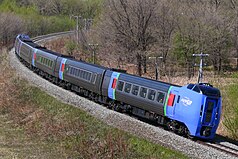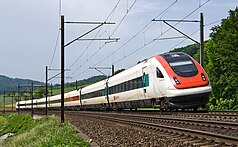
Back Tren pendular Catalan Drážní vozidlo s naklápěcí skříní Czech Krængeteknik Danish Neigetechnik German Tren pendular Spanish Kallistuvakorinen juna Finnish Train pendulaire French רכבת רוכנת HE Nagibni vlak Croatian Billenőszekrényes járművek Hungarian
A tilting train is a train that has a mechanism enabling increased speed on regular rail tracks. As a train (or other vehicle) rounds a curve at speed, objects inside the train experience centrifugal force. This can cause packages to slide about or seated passengers to feel squashed by the outboard armrest, and standing passengers to lose their balance, or in such excessive speeds, could even cause the train to derail. Tilting trains are designed to counteract this by tilting the carriages towards the inside of the curve, thus compensating for the g-force. The train may be constructed such that inertial forces cause the tilting (passive tilt), or it may have a computer-controlled powered mechanism (active tilt).
The first passive tilting car design was built in the US in 1937, and an improved version was built in 1939. The beginning of World War II ended development. Talgo introduced a version based on their articulated bogie design in 1950s, and this concept was used on a number of commercial services. Among these was the UAC TurboTrain, which was the first (albeit short-lived) tilting train to enter commercial service in 1968 in the US and Canada. Japan similarly experimented, from the late 1960s, through the 591 Series[1] that developed into the highly successful Hitachi 381 series, that has been in service since 1973. In parallel Fiat Ferroviaria produced the experimental Y 0160 in 1970, that would evolve into the Pendolino family, in 1976, and operated in 11 countries. All of these had problems with short curves like those in switchyards, where they tended to sway about. Also, because of the way the carriages always swung outward, they placed more weight on the outside of the curve, which limited their improvement in cornering speed to about 20%.
Starting in the late 1960s, British Rail also began experiments with its Advanced Passenger Train (APT) which pioneered the active-tilt concept, along with in-cab signalling, to permit High Speed Rail services on conventional tracks. The APT family used hydraulic rams on the bottoms of the carriages to tilt them, rotating them around their centre point rather than swinging outward. This had the advantage of keeping the carriage centred over the bogies, which reduced load on the rails, and could be turned off when navigating switches. Due to lengthy political delays, the APT did not begin service testing until 1979, entering limited scheduled service in December 1981, the media describing the initial revenue run as both fifteen years late, and the queasy rider; the sets only briefly entering full revenue operation in 1985, before being withdrawn and the associated technologies sold to Alstom / Fiat Ferroviaria.[2][3] By this time, the Canadian LRC design had become the first active tilting train to enter full commercial service, starting with Via Rail in 1981.
- ^ プロトタイプの世界 - Prototype World (in Japanese). Japan: Kōtsū Shimbunsha. December 2005. pp. 12–19. OCLC 170056962.
- ^ "APT - With Hindsight by Professor Alan Herbert Wickens". www.apt-p.com. Retrieved 16 June 2024.
- ^ "APT tilting train: The laughing stock that changed the world". BBC News. 18 December 2015. Retrieved 16 June 2024.
© MMXXIII Rich X Search. We shall prevail. All rights reserved. Rich X Search



